How Do Septic Tanks Work?
Septic tanks play a vital role in managing household waste, particularly in areas where a municipal sewer system is not available.
They are especially common in rural regions, where connecting to a central sewage system can be impractical or too expensive.
Properly functioning septic tanks are essential for maintaining a healthy and hygienic living environment.
Without them, waste disposal becomes a significant challenge, potentially leading to environmental contamination and health risks.
But exactly how do septic tanks work?
Understanding how septic tanks work is crucial for homeowners.
This article aims to provide an overview of septic tanks – what they are, how septic tanks work, the different types, their advantages and disadvantages, as well as alternatives. .
Article Chapters
What is a Septic Tank
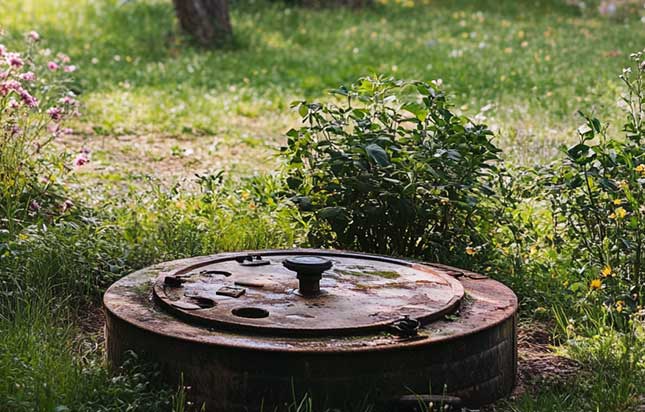
A septic tank is an underground structure made from concrete, fibreglass, or plastic.
It is part of an on-site sewage facility used to manage and treat household wastewater in areas without access to municipal sewer systems.
Septic tanks are commonly found in rural and suburban areas, where connecting to a centralised sewage system is impractical or too costly.
They are designed to hold wastewater from homes, including from toilets, sinks, and showers.
Septic tanks come in various sizes and types, tailored to meet the specific needs of different properties and household sizes.
How Do Septic Tanks Work?
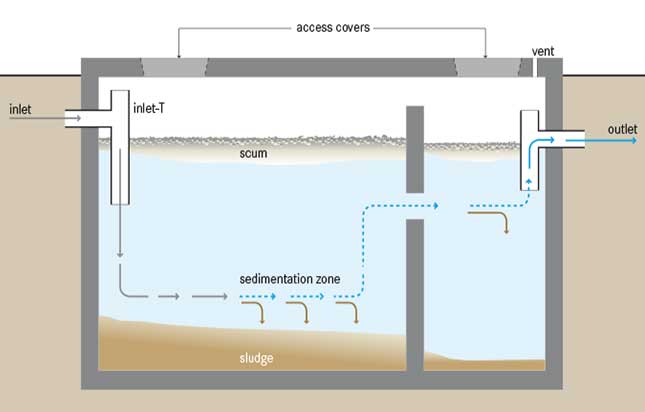
Source: Wikipedia
Septic tanks operate through a natural process to treat and manage household wastewater.
Here’s a step-by-step explanation of how they work:
Wastewater Collection
When you flush a toilet, drain a sink, or use any other water fixture in your home, wastewater flows through pipes into the septic tank.
This tank is typically buried underground and is designed to handle all the wastewater from your home.
Separation of Solids and Liquids
Inside the septic tank, the wastewater undergoes a process of separation.
Heavier solids, such as food particles and human waste, settle at the bottom of the tank, forming a layer of sludge.
Lighter materials like oils and grease rise to the top, creating a layer of scum.
The middle layer, consisting of relatively clear liquid, is known as effluent.
Bacterial Breakdown
The septic tank contains natural anaerobic organisms that break down the organic matter in the sludge and scum.
This bacterial action reduces the volume of solid waste and helps in partially treating the wastewater.
The breakdown process converts solid waste into simpler compounds, which can be more easily managed by the system.
Effluent Flow to the Drain Field
After the initial treatment in the septic tank, the effluent flows out of the tank through an outlet pipe.
It then moves into a drain field, also called a leach field.
The drain field consists of a network of perforated pipes buried in gravel-filled trenches.
The effluent slowly seeps out of these pipes and is dispersed into the surrounding soil.
Final Treatment
As the effluent percolates through the soil in the drain field, it undergoes further natural filtration and treatment.
The soil and its microorganisms continue to break down and filter out contaminants, ultimately purifying the water before it re-enters the groundwater supply.
Maintenance
To ensure proper function, septic tanks require regular maintenance, including periodic pumping to remove accumulated sludge and scum.
Neglecting maintenance can lead to system failures and costly repairs.
What are the Different Types of Septic Tanks?
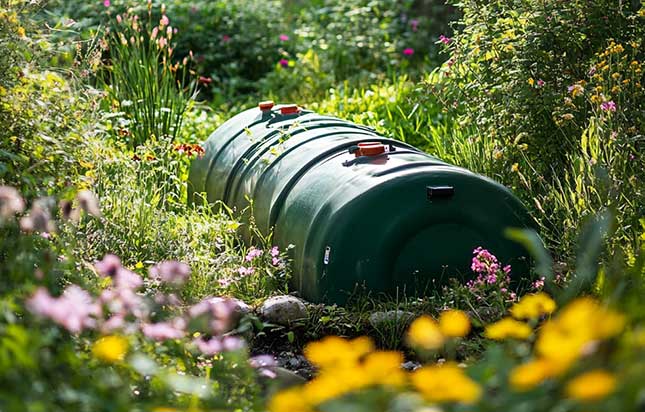
Septic tanks come in several types, each designed to meet different needs and conditions.
Here are the most common types:
Concrete Septic Tanks
Concrete septic tanks are the most traditional and widely used.
They are durable, strong, and can last for decades with proper maintenance.
However, they can be prone to cracking over time if not properly installed or maintained.
Fibreglass Septic Tanks
Fibreglass tanks are lightweight and resistant to corrosion.
They are less likely to crack compared to concrete tanks and are easier to install.
However, they can be damaged by heavy loads or improper handling.
Plastic Septic Tanks
Plastic septic tanks are similar to fibreglass in that they are lightweight and resistant to rust.
They are generally easy to install and less prone to cracking.
However, plastic tanks may be less durable under extreme conditions and can be affected by ground movement.
Aerobic Septic Tanks
Aerobic septic tanks use an aerobic treatment process, which involves adding air to the tank to enhance bacterial activity.
This results in more effective waste breakdown and is beneficial in areas with poor soil conditions.
Aerobic tanks are more complex and require an electrical supply to operate the air pump.
What are the Advantages of Septic Tanks?

Septic tanks offer several advantages, especially in areas where municipal sewer systems are not available:
Cost-Effectiveness
One of the primary advantages of septic tanks is their cost-effectiveness.
Installing a septic system can be significantly cheaper than connecting to a normal sewer line, particularly if you live in a rural or remote area.
Maintenance costs are also relatively low, involving periodic pumping and inspections.
Environmental Benefits
Septic tanks treat wastewater on-site, reducing the strain on municipal sewage treatment facilities.
This decentralised approach can be more environmentally friendly, as it minimises the risk of overloading centralised systems and helps to reduce pollution.
Properly maintained septic systems also effectively filter wastewater before it re-enters the groundwater.
Independence
Septic tanks provide a level of independence from municipal services.
For homeowners in rural or less-developed areas, this means they are not reliant on local sewer systems, which can be unreliable or non-existent.
This independence can be particularly advantageous during service disruptions or when local sewer infrastructure is insufficient.
Simple Maintenance
With proper care, septic systems are relatively easy to maintain.
Regular pumping to remove sludge and scum, along with responsible water usage, helps ensure the system operates efficiently.
Preventive maintenance can extend the lifespan of the septic tank and reduce the likelihood of costly repairs.
Flexibility and Adaptability
Septic systems can be adapted to various soil types and property sizes.
They are versatile solutions that can be customised to fit specific needs, making them suitable for a wide range of residential settings.
What are the Downsides to Septic Tanks?

While septic tanks offer many benefits, they also come with several downsides that homeowners should consider:
Regular Maintenance
One of the major drawbacks of septic tanks is the need for regular maintenance.
Septic systems require periodic pumping, typically every 3-5 years, to remove accumulated sludge and scum.
Failure to perform this maintenance can lead to system malfunctions, backups, garden flooding, and costly repairs.
Homeowners must also be wary of substances that can harm the bacteria essential for breaking down waste.
Potential for Contamination
If a septic system fails, it can lead to groundwater contamination.
This can be particularly problematic in areas with high water tables or close proximity to drinking water sources.
Contaminated groundwater poses health risks and can affect local ecosystems.
Proper installation and regular monitoring are crucial to prevent such issues.
Limited Lifespan
Septic tanks have a finite lifespan, generally around 20-30 years, depending on the material and maintenance.
Over time, tanks can deteriorate due to environmental factors or poor maintenance, leading to potential system failures and the need for costly replacements.
Soil Dependency
The effectiveness of a septic system depends on the quality of the surrounding soil.
Poor soil conditions, such as high clay content or excessive moisture, can hinder the system’s ability to effectively treat and absorb wastewater.
In such cases, additional measures or alternative systems may be required.
Space Requirements
Septic systems need adequate space for both the tank and the drain field.
This can be a limitation for smaller properties or areas with restricted land.
Installing a septic system in such conditions may require additional planning and possibly higher costs.
What are the Alternatives to Septic Tanks?
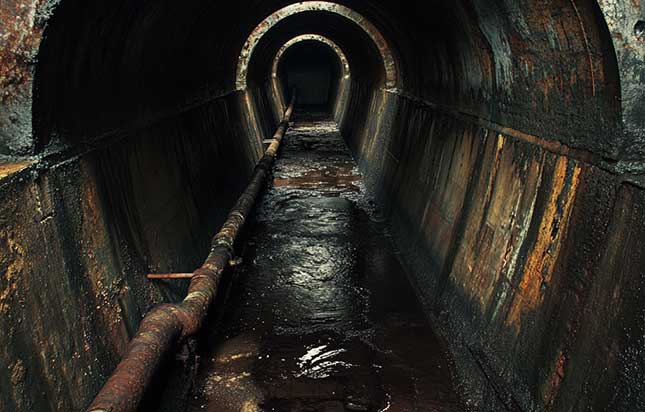
If a traditional septic tank system isn’t suitable for your property or you’re exploring other options, several alternatives can effectively manage household wastewater.
Here are some alternatives:
Sewer Systems
Sewer systems are the most straightforward alternative to septic tanks.
They transport wastewater from homes to a central treatment facility where it is processed and treated.
This option is ideal for urban and suburban areas where sewer infrastructure is available.
It eliminates the need for on-site wastewater management and reduces the risk of system failures.
Composting Toilets
Composting toilets use little to no water and convert human waste into compost through aerobic decomposition.
These systems are highly eco-friendly and ideal for off-grid living or areas with water scarcity.
The compost produced can be safely used as a soil conditioner.
However, composting toilets require careful management and regular maintenance to avoid odours and ensure effective composting.
Greywater Systems
Greywater systems recycle water from sinks, showers, and washing machines.
This water is collected and treated for reuse in irrigation or flushing toilets.
Greywater systems reduce the load on septic tanks or sewer systems and conserve water.
They are particularly useful in drought-prone areas but require proper filtration and maintenance to prevent contamination.
Holding Tanks
Holding tanks temporarily store wastewater until it can be transported and treated elsewhere.
These tanks are used in situations where long-term wastewater treatment on-site is impractical, such as for temporary or seasonal use.
Regular pumping is necessary to remove the accumulated waste.
Conclusion
Hopefully you now have more of an understanding of exactly how septic tanks work.
Septic tanks are an essential solution for wastewater management in areas without sewer systems.
While septic systems have advantages like cost-effectiveness and environmental friendliness, they also come with downsides such as regular maintenance and potential contamination risks.
Alternatives like sewer systems, composting toilets, and greywater systems provide other options for managing household waste.
Understanding how septic tanks work and their pros and cons can help you make informed decisions about your home’s wastewater management needs.

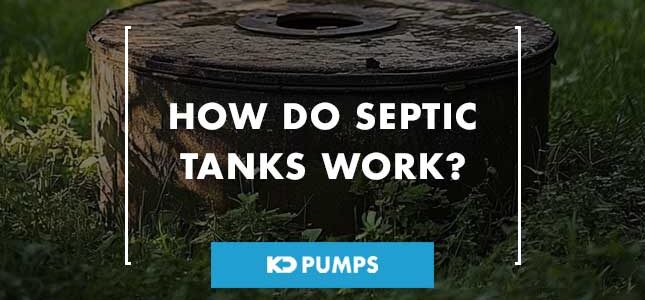
Comments are closed.